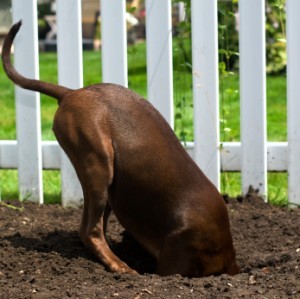 If you have a yard that your dogs can play in, how do you keep them inside it? A traditional fence is the most popular solution, and it’s a no-brainer: just put it up, and your dogs stay in. Well, most of the time they do. Some people have trouble containing their dogs with a traditional fence, because dogs who are determined escape artists may find ways to dig under or break through no matter what. And for some people, traditional fences aren’t options. A strict housing association may prohibit fences, for example; or the landscape may be too restrictive.
If you have a yard that your dogs can play in, how do you keep them inside it? A traditional fence is the most popular solution, and it’s a no-brainer: just put it up, and your dogs stay in. Well, most of the time they do. Some people have trouble containing their dogs with a traditional fence, because dogs who are determined escape artists may find ways to dig under or break through no matter what. And for some people, traditional fences aren’t options. A strict housing association may prohibit fences, for example; or the landscape may be too restrictive.
An electronic dog fence can be a great alternative to a traditional fence, but as with any major decision for your pets, the pros and cons should be weighed. If you’re thinking about using an invisible fence to contain your dogs, here are some of the upsides and downsides to keep in mind before making a purchase.
Pros
Reliability
The most important element of any safety measure is its reliability. If you can’t rely on your fence to keep your dogs in your yard, what is the point? Invisible dog fences are reliable, and they can be even more so than traditional fences. For example, a regular fence won’t notify you if a portion of it breaks due to the weather or other factor. The main unit of an invisible fence system will let you know immediately if there is a break that would put your dogs at risk of escape. Even better, a properly installed underground dog fence will very rarely require maintenance or repair. If you purchase a system that has battery backup, it will work even in the event of a power outage.
Invisible dog fences are also extremely reliable because most employ two layers of protection for your dogs. When your dogs approach the perimeter, their e-collars will emit a warning tone. At this point, most dogs will stop and turn back. If your dogs ignore the beeping, a mild corrective shock will warn them that they’ve reached their boundaries. Because of these mechanisms, invisible dog fences are also more reliable for dogs who enjoy digging or jumping; their e-collars won’t allow them to get close enough to the boundary to find a way through it.
Customization
A wired dog fence also gives you a bigger range of options when it comes to placement. Rigid fence sections can’t always be placed in desired areas, and you’re limited in how they can be arranged. Wire is much more malleable, and you’re able to lay it in any shape or formation you desire. It can be placed on rough or uneven terrain, or close to walls or other obstacles in the yard. You can also create exclusion zones within your yard to keep your dogs out of your garden, for example. If you have a small yard, an invisible dog fences allows you to maximize the area your dogs can roam. For very large yards, a DIY electric dog fence allows you to enclose all of it without spending a fortune on a traditional fence, because wire is much less expensive.
Cost
Not only is additional wire much less expensive than additional fence sections, the entire cost of a DIY electric dog fence is less. Highly rated units, such as the PetSafe YardMax, cost as little as $300. If you need more than the one e-collar the unit comes with, you’ll only need to spend $60-$100 more on each additional e-collar. Installing your own invisible dog fence will save you at least $1200 on installation fees. In general, DIY invisible dog fences cost at least 80 percent less than traditional fences in the same yard. And if you’re worried about the cost of electricity for running an invisible fence, don’t be – your electric bill will only raise about $1-$2 per month.
Cons
Installation
While installing your own electric dog fence will save you a significant amount of money, you do have to do the work required to get it up and running. You don’t need any expertise to install a dog fence – just the willingness to read the manual and follow the instructions. However, some people would rather pay to have the work done. Depending on the size of your yard, an invisible dog fence can be installed as a weekend project. Underground dog fences will require digging, for which you can rent a trencher if you prefer. If you’d rather not take the time, a wireless dog fence is another option that is quicker and easier to install.
Training
The most important aspect of installing an invisible dog fence is training your dogs to understand the new system. With proper training, your dogs will learn the perimeter and won’t experience the uncomfortable corrective shock unless they deliberately ignore their boundaries. After you’ve installed your electronic dog fence, you’ll need to spend about 15-30 minutes twice a day for up to two weeks. It’s essential that you follow the dog fence training instructions to the letter. If you don’t have the time or patience for this training, then an invisible dog fence isn’t right for you.
If you’re interested in installing your own invisible fence, there are lots of online invisible fence reviews that are extremely helpful for selecting your system. There are many different brands and models of electronic dog fences, and each have their own pros and cons. For example, not all have battery backup, and some are limited in the size of yard they can contain, especially wireless dog fences. With your due diligence and your devotion to your pets’ safety, you’ll have no problem choosing the right method to ensure your dogs stay safe in your yard.
For more information about dog fences please visit our educational partner www.dogfencediy.com. We encourage you to share your experiences with a variety of dog containment systems in the comments section. Commenters and those who share the post in social media qualify for a drawing of a $25 Amazon gift card!
Submit your review | |











My wife and I have been thinking about getting an invisible fence in the backyard for the dog, so thanks for sharing this guide. I like your point about how you’ll have to spend about 15-30 minutes twice a few for a few weeks to get your dog trained. We’ll be sure to get him accustomed to it before letting him roam free in the yard again. Thanks for sharing.